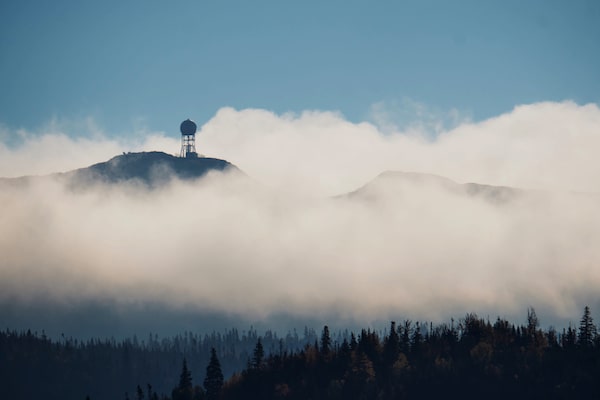
The old Marble Mountain weather radar in western Newfoundland, seen here in 2016, was replaced in 2022 as part of the Canadian Weather Radar Replacement Program.Scott Grant/The Globe and Mail
As post-tropical storm Fiona devastated much of Atlantic Canada last month, Robert Way watched in horror as hurricane-force winds and heavy rainfall wreaked havoc across much of the region.
A Queen’s University geography professor and climate change researcher, he was out of harm’s way in Happy Valley-Goose Bay in central Labrador. But Prof. Way worried what might happen if the storm had tracked further north, out of range of Environment and Climate Change Canada’s weather radar.
“As the storm moves northwards we lose critical radar coverage of areas that may be affected. Canada has not properly invested in radar infrastructure in most of Canada,” Prof. Way tweeted on Sept. 24.
Weather radars are a key element to forecasting short-term severe weather such as thunderstorms, tornadoes, hail, extreme rain and ice storms. But Environment Canada does not operate any weather radars in Labrador, the territories or the northern parts of British Columbia, Alberta, Saskatchewan, Manitoba, Ontario and Quebec.
“There’s no radar coverage across large swaths of land,” Prof. Way said.
The majority of Canadians are covered because they live in the south. But the areas that don’t have radar are the ones expected to bear the greatest impact of climate change. “They have a high reliance on what the weather is doing. They also have the least infrastructure to deal with climate change and many are fly-in only communities,” Prof. Way said.
Canada’s weather-radar network is undergoing a modernization project that was launched in 2017.
“Weather radars are the primary tool used by our meteorologists to issue more precise and timely severe weather warnings in Canada,” Samantha Bayard, a spokesperson for Environment and Climate Change Canada, said in an e-mail to The Globe and Mail.
“Replacing the aging network with new modern weather radars will ensure Canadians are better informed about changing weather,” she said.
But even once the updates are completed next year, more than 460,000 Canadians and just under two-thirds of the country’s land mass will remain without weather radar coverage. Most people excluded from the coverage live in the North, in remote communities and are Indigenous. For example, coverage excludes the entirety of Inuit Nunangat, the homeland of the Inuit.

Canadian weather radar coverage
Updates to the Canadian Weather Radar Network will expand doppler and conventional radar coverage for most Canadians, but leaves two-thirds of Canada’s land mass and some 460,000 Canadians out of range.
Old weather radar coverage
New weather radar coverage
the globe and mail, Source: meteorological
service of canada

Canadian weather radar coverage
Updates to the Canadian Weather Radar Network will expand doppler and conventional radar coverage for most Canadians, but leaves two-thirds of Canada’s land mass and some 460,000 Canadians out of range.
Old weather radar coverage
New weather radar coverage
the globe and mail, Source: meteorological
service of canada

Canadian weather radar coverage
Updates to the Canadian Weather Radar Network will expand doppler and conventional radar coverage for most Canadians, but leaves two-thirds of Canada’s land mass and some 460,000 Canadians out of range.
Old weather radar coverage
New weather radar coverage
the globe and mail, Source: meteorological service of canada
While most northern communities have local ground-based weather stations, which offer basic weather information such as air temperature, precipitation and wind speeds, Prof. Way said the lack of radar coverage hampers travel, especially for fly-in communities.
“If you don’t know or have a good idea of what’s going on in the sky between two points, then it increases the likelihood of delayed or cancelled flights,” he said.
As weather patterns continue to change, often unpredictably, it’s best that people have more tools at their disposal, said Joel Finnis, a climatologist at Memorial University of Newfoundland in St. John’s.
“Climate change means the weather you’re used to is not necessarily the weather you’ll get. When unexpected or unusual weather arrives, the more information you can get the better. Radar provides some critical information on weather as it’s happening and, consequently, can be extremely useful in these situations,” Prof. Finnis said.
The modernization of Canada’s weather radar network will help meteorologists adjust forecasts more quickly because they offer more information, more often.
With updates to conventional radars, forecasters will be better able to distinguish between types of precipitation, such as rain, snow, hail and freezing rain. The new radars will also have an extended detection range – called a Doppler range – which will allow more lead time for people to take appropriate actions to protect themselves and their property from the effects of severe weather.
Doppler radar is particularly important for the detection of rotation patterns in wind speeds, providing advance warning for tornadoes. The updated radars can also go deeper into dense storms and require less maintenance than older models.
In addition to relying on local weather stations, Environment Canada meteorologists support weather forecasting through such sources as satellite imagery, lightning detection equipment, weather buoys and ship reports. They also rely on computer modelling to predict developing weather events.